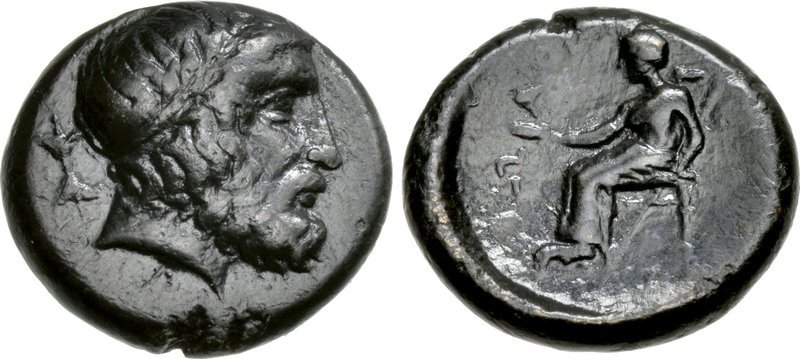AC 155 - Dium, bronze (Zeus/Demeter) (400-350 BCE)
From SILVER
400 BCE - 350 BCE Bronze
Description
| ObverseInscription or printing placed on the obverse.: | Head of Zeus right, hair bound with tainia in the form of a wreath, vertical thunderbolt behind. |
| ReverseInscription or printing placed on the reverse.: | [ΔΙ]Α-ΩИ (Greek).Demeter in long chiton seated left on throne with a back, feet on footstool, phiale in outstretched right hand, sceptre held diagonally in left, below throne, small Δ. |
Mint and issuing power
| MintIdentifies the place of manufacture or issue of a numismatic object.: | Dium | Ancient regionAncient region.: | Macedon | Modern countryModern country: Greece | AuthorityIdentifies the issuing power. The authority can be "pretended" when the name or the portrait of X is on the coin but he/she was not the issuing power. It can also be "uncertain" when there is no mention of X on the coin but he/she was the issuing power according to the historical sources: |
Chronology
| FromIdentifies the initial date in a range assigned in a numismatic context. | 400 BCE | toIdentifies the final date in a range assigned in a numismatic context.. | 350 BCE | PeriodTime period of the numismatic object.: Classical 480-323 BC |
Physical description
| MetalThe physical material (usually metal) from which an object is made.: | Bronze |
Median weightMedian of the weights of numismatic objects (in grams). in grams | 2.20 | DenominationTerm indicating the value of a numismatic object. Examples: tetradrachm, chalkous, denarius.: | StandardStandard.: |
Image

AC155 Dion.jpeg [1]
References
| Die study referencePublication of the study: | Demetriadi 19981Demetriadi 1998, p. 115-117, pl. 28. | ||
| Coin series referenceReference to coin series study: | RQEMAC2RQEMAC, n° 155 | ||
Obverse dies distribution
| FrequencyFrequency of specimen in distribution. ᵖ | Number of obversesNumber of obverse dies. ᵖ (o) | % (o) | Number of coinsNumber of coins. (n) | % (n) | Die nameName(s) of the die(s). |
| 1 | 1 | 33.33 | 1 | 9.09 | 3 |
| 2 | 1 | 33.33 | 2 | 18.18 | 2 |
| 8 | 1 | 33.33 | 8 | 72.73 | 1 |
| Total | 3 of 3 | 99.99 | 11 of 11 | 100 |
Reverse dies distribution
no distribution is available
Quantification
| Number of obversesNumber of obverse dies. ᵖ (o) | 3 | Number of singletons (o1)The number of singleton coins. ᵖ | 1 |
| Number of reverse diesNumber of reverse dies. (r) | 3 | Number of coinsNumber of coins. (n) | 11 |
| Coins per obverse dieNumber of coins per obverse die. (n/o) | 3.67 | Coins per reverse dieNumber of coins per reverse die. (n/r) | 3.67 |
| Reverse per obverse ratioRatio of obverse dies divided by reverse dies. (r/o) | 1 | Percentage of singletons (o1)number of coins (n) divided by the number of singletons (o1) ᵖ | 33.33 % |
| Original number of dies (O) (Carter 1983 formula)The estimation of the number of coins according to Carter 1983 ᵖ | 3.58 | Coins struck if 20,000 as average productivity per dieCoins made if the average productivity for obverses (according to Carter) is 20,000. ᵖ | 71,600 |
| Original number of dies (O) (Esty 2011 formula)The estimation of the number of coins according to the singleton formula in Esty 2011 ᵖ (O) | 4.13 | Survival rate if 20,000 as average productivity per dieSurvival rate if average productivity is 20,000. ᵖ | 0.00015 |
| Coverage (o = % of O) (Esty 1984 formula)Esty 1984 - coverage (% of O) ᵖ (o = % of O) | 90.91% | Die productivity if survival rate 1/2,000Average productivity if survival rate is 1/2,000. ᵖ | 6,145.25 |
| Weight of silver (in kg) if 20,000 coins per die (O = Carter formula)Carter 1983 * Median weight * 20000 (*10 if gold or electrum) ᵖ | n.a. | Die productivity if survival rate 1/5,000Average productivity if survival rate is 1/5,000. ᵖ | 15,363.13 |
Remarks
References
- ^ Vassili Demetriadi (1998), "Dion in Macedonia : a Bronze Coinage of the Classical Period", in R. Ashton and S. Hurter (eds.), Studies in Greek Numismatics in Memory of Martin Jessop Price, London, p. 115-117, pl. 28.
- ^ Callataÿ, François de (2003), Recueil quantitatif des émissions monétaires archaïques et classiques, Numismatique Romaine, Wetteren, VII + 267 p.